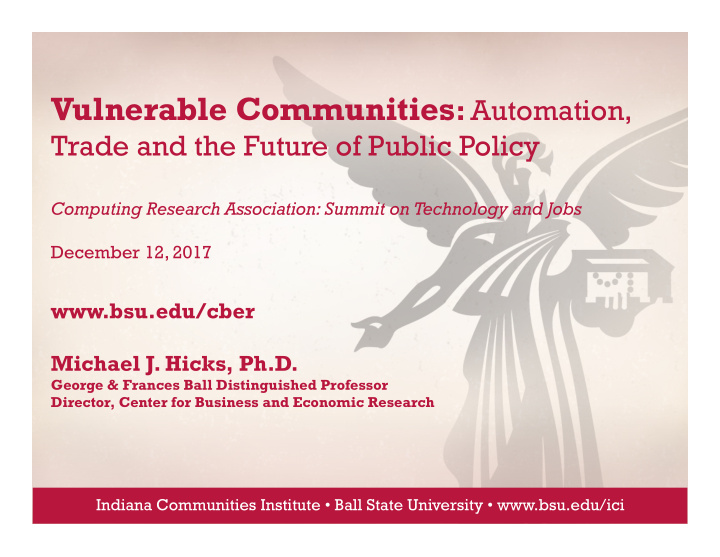



Vulnerable Communities : Automation, Trade and the Future of Public Policy Computing Research Association: Summit on Technology and Jobs December 12, 2017 www.bsu.edu/cber Michael J. Hicks, Ph.D. George & Frances Ball Distinguished Professor Director, Center for Business and Economic Research Indiana Communities Institute • Ball State University • www.bsu.edu/ici
Indiana Communities Institute Research: economics, sociology, political science, public administration and planning Research Policy Policy: former agency heads, elected officials and legislative services veterans Practice: former economic and community development officials Practice Indiana Communities Institute • Ball State University • www.bsu.edu/ici
A Puzzle . . . The impulse-response of a one-std. dev. shock of technology and cost of capital on the unemployment rate Labor is complement to capital Technology shocks reduce unemployment Indiana Communities Institute • Ball State University • www.bsu.edu/ici
Liverpool and Muncie . . . Vulnerable communities Indiana Communities Institute • Ball State University • www.bsu.edu/ici
Robots are Complements to Workers? But not necessarily in the same factory Indiana Communities Institute • Ball State University • www.bsu.edu/ici
US Relative Offshorability Risk to Employment Source: Blinder, 2009 in Devaraj, Hicks, Wornell and Faulk, 2017 Indiana Communities Institute • Ball State University • www.bsu.edu/ici
US Relative Automation Risk to Employment Source: Frey and Osborne, 2017 in Devaraj, Hicks, Wornell and Faulk, 2017 Indiana Communities Institute • Ball State University • www.bsu.edu/ici
Change in Trade Exposure (2000-2010) Source: Hicks and Devaraj Indiana Communities Institute • Ball State University • www.bsu.edu/ici
Automation Risk in Own County and Offshoring Risk in Own County and Average of Adjacent Counties Average of Adjacent Counties Source: Frey and Osborne (2017), reported in Source: Blinder (2009), reported in Devaraj, Devaraj, Hicks, Wornell and Faulk, 2017 Hicks, Wornell and Faulk, 2017 Indiana Communities Institute • Ball State University • www.bsu.edu/ici
Automation and Offshoring Risk by Income Decile Source: Bureau of Labor Statistics, Blinder (2009) and Frey and Osborne (2017) in Devaraj, Hicks, Wornell and Faulk, 2017 Indiana Communities Institute • Ball State University • www.bsu.edu/ici
Policies on Trade, People and Places • What is the problem/welfare impacts? • Trade and Technology Policies • People-Based Policies • Place-Based Policies • Place-Based People Policies Indiana Communities Institute • Ball State University • www.bsu.edu/ici
Source of pain isn’t just labor income? log-log change in home prices and manufacturing employment 2000-2010 (non-metro counties) • Just this estimate implies a nearly $500 billion loss of wealth concentrated in manufacturing intensive communities Indiana Communities Institute • Ball State University • www.bsu.edu/ici
Muncie’s Experience (Hicks, 2017) Indiana Communities Institute • Ball State University • www.bsu.edu/ici
Skepticism on Trade Policy • This implies an elasticity of productivity with respect to trade Pure Pure pressure of roughly 3.5 (assuming Productiv Trade, circa 2000 technology) ity, 47.0% 13.0% • We can re-shore manufacturing production, just not manufacturing Trade jobs induced Productiv ity , 40.0% • See Pierce and Schott; Autor, Dorn, and Hanson; Hicks and Devaraj Indiana Communities Institute • Ball State University • www.bsu.edu/ici
Traditional People Based Policies • $1,000 increase in trade exposure • Change in EITC due to trade per worker leads to a $57.73 exposure in US Counties increase in public spending (Hicks and Devaraj) (Autor, Dorn and Hanson) UI and TAA 7% Medical SSA 33% Disability 15% SSA Retirement 18% Other Gov't 27% Indiana Communities Institute • Ball State University • www.bsu.edu/ici
Place-Based Policies Traditional local economic development policies have • been poorly conceived (chasing smokestacks), with fairly dismal empirical support. Regional based Federal and state policies (e.g. • enterprise or empowerment zones) have a highly heterogeneous effect, difficult to assess effectively, and costly to deploy broadly. Not at all clear existing agglomeration economies • wouldn’t swamp even ambitious (TVA scale) place based policies. Poor places are moving against trend. Indiana Communities Institute • Ball State University • www.bsu.edu/ici
Cumulative Growth in Footloose and NonFootloose Jobs in the US (1969-2015) Indiana Communities Institute • Ball State University • www.bsu.edu/ici
Place-Based People Policies Small scale place-based people policies (Moving to • Opportunity) show promise, but may not be scalable. Heterogeneity of federal and state programs may be • linked to local capacity. Indiana’s Regional Cities and Stellar Communities are • capacity building programs with infrastructure (link capacity to program eligibility) Not clear this will reduce regional growth differences, • and may exacerbate it (even if welfare enhancing) Indiana Communities Institute • Ball State University • www.bsu.edu/ici
Summary Trade, automation and agglomeration are generating • significant regional differences in economic outcomes. These differences are visible, persistent and generate • both social and political consequences. People and place based policies aren’t clearly reducing • regional inequality or the persistence of shocks. Persistence of effects is generational in people, may be • multi-generational for places. Indiana Communities Institute • Ball State University • www.bsu.edu/ici
cberdirector@bsu.edu www.bsu.edu/cber http://projects.cberdata.org/ Indiana Communities Institute • Ball State University • www.bsu.edu/ici
Recommend
More recommend